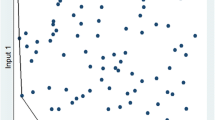Abstract
Data envelopment analysis (DEA) is widely used to compare the empirical performance of public institutions such as law enforcement agencies, judicial authorities or national health care systems. Many DEA analysts, however, ignore the fact that DEA efficiency values are non-metric. They consequently do not hesitate to compute (arithmetic) means. They do not hesitate either to treat DEA values as metric data in econometric analyses. Instead of providing useful insights into the performance of public bodies, the confusion of non-metric data with metric data constitutes a lack of internal validity that may cause serious fallacies. Against this background, we believe that a clear warning against an uncritical processing and interpretation of DEA values is pertinent and should be routinely considered by efficiency analysts as well as referees of efficiency papers.

Similar content being viewed by others
References
Charnes, A., Clark, C. T., Cooper, W. W., & Golany, B. (1985). A developmental study of data envelopment analysis in measuring the efficiency of maintenance units in the US air forces. Annals of Operations Research, 2(1), 95–112.
Charnes, A., Cooper, W., & Rhodes, E. (1978). Measuring the efficiency of decision making units. European Journal of Operational Research, 2(6), 429–444.
Charnes, A., Cooper, W., & Rhodes, E. (1981). Evaluating program and managerial efficiency: An application of data envelopment analysis to program follow through. Management Science, 27(6), 668–697.
Coelli, T., Prasada Rao, D. S., & Battese, G. E. (1998). An introduction to the efficiency and productivity analysis. Norwell: Kluwer Academic Publishers.
Emrouznejad, A., Parker, B. R., & Tavares, G. (2008). Evaluation of research in efficiency and productivity: A survey and analysis of the first 30 years of scholarly literature in DEA. Socio-Economic Planning Sciences, 42, 151–157.
Farrell, M. J. (1957). The measurement of productive efficiency. Journal of the Royal Statistical Society, Series A (General), 120(3), 253–290.
Kocher, M. G., Luptacik, M., & Sutter, M. (2006). Measuring productivity of research in economics: A cross-country study using DEA. Socio-Economic Planning Sciences, 40(4), 314–332.
Ray, S. C. (2004). Data envelopment analysis: Theory and techniques for economics and operations research. New York: Cambridge University Press.
Rosenberg, D. (1991). DEA or dubious efficiency assessment? Journal of Health and Human Resources Administration, 14(1), 65–76.
Schneider, M. (2005). judicial career incentives and court performance: An empirical study of the German labour courts of appeal. European Journal of Law and Economics, 20, 127–144.
Stevens, S. S. (1946). On the theory of scales of measurement. Science, 103(2684), 677–680.
Author information
Authors and Affiliations
Corresponding author
Rights and permissions
About this article
Cite this article
Hirschauer, N., Musshoff, O. Non-metric data: a note on a neglected problem in DEA studies. Eur J Law Econ 37, 489–494 (2014). https://doi.org/10.1007/s10657-013-9429-5
Published:
Issue Date:
DOI: https://doi.org/10.1007/s10657-013-9429-5




